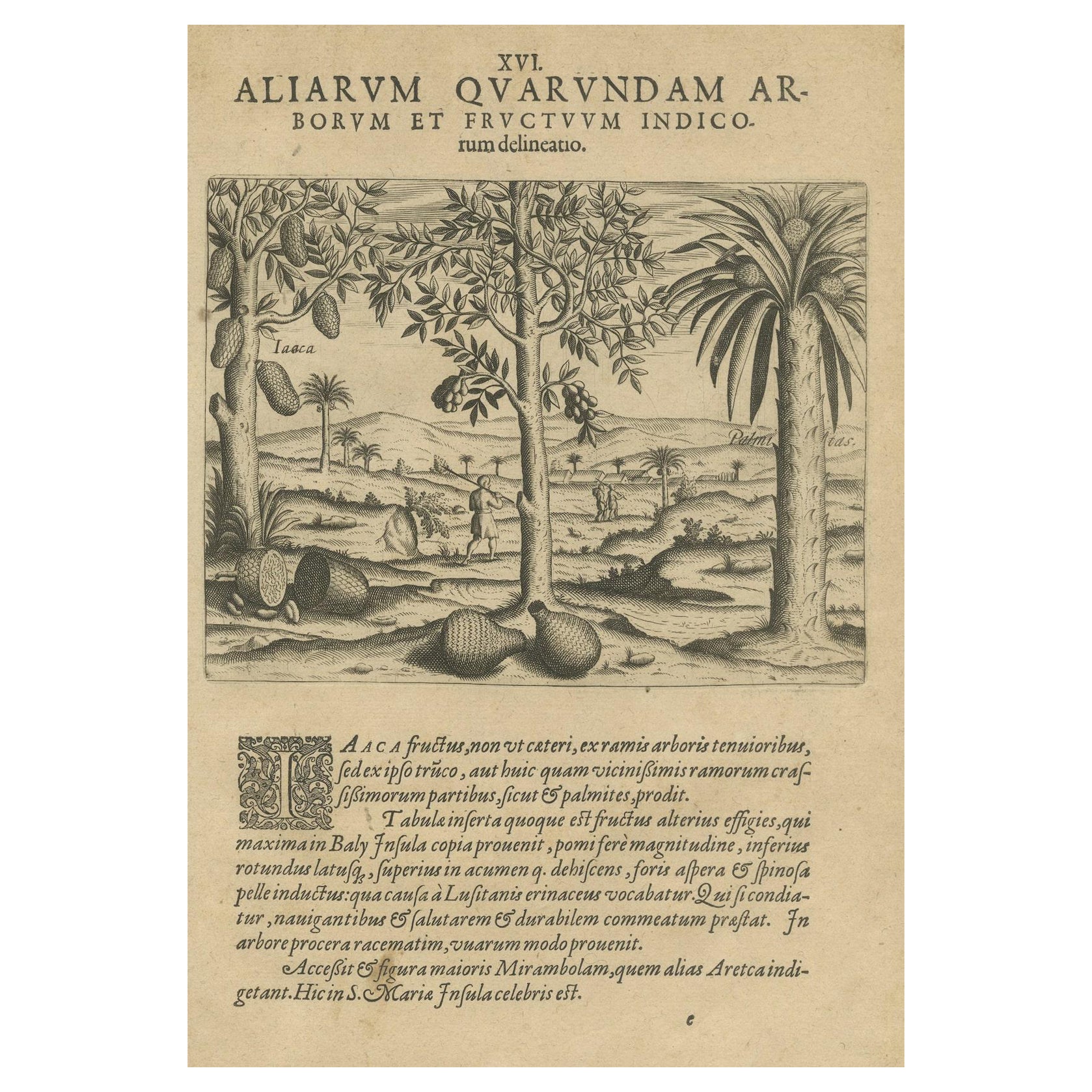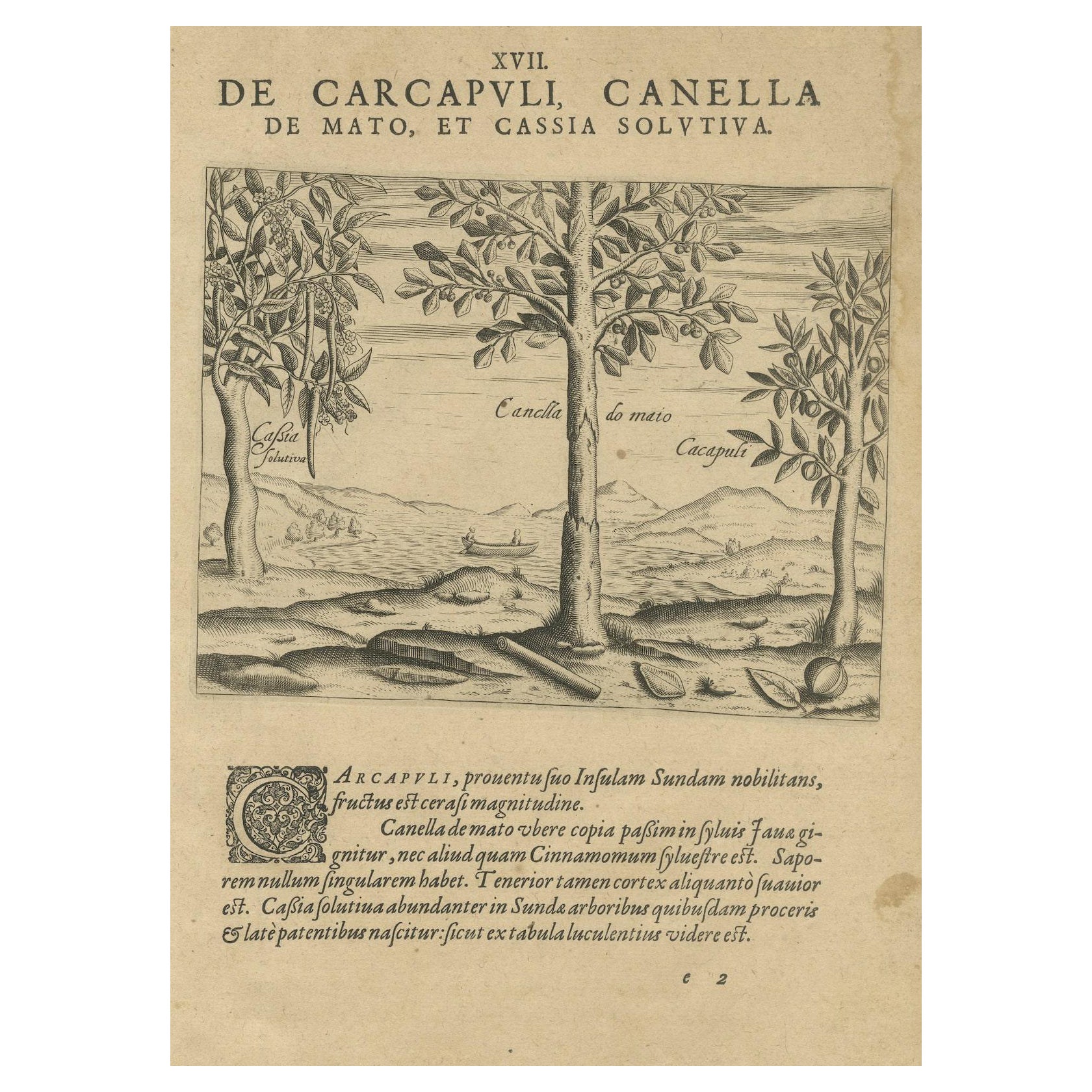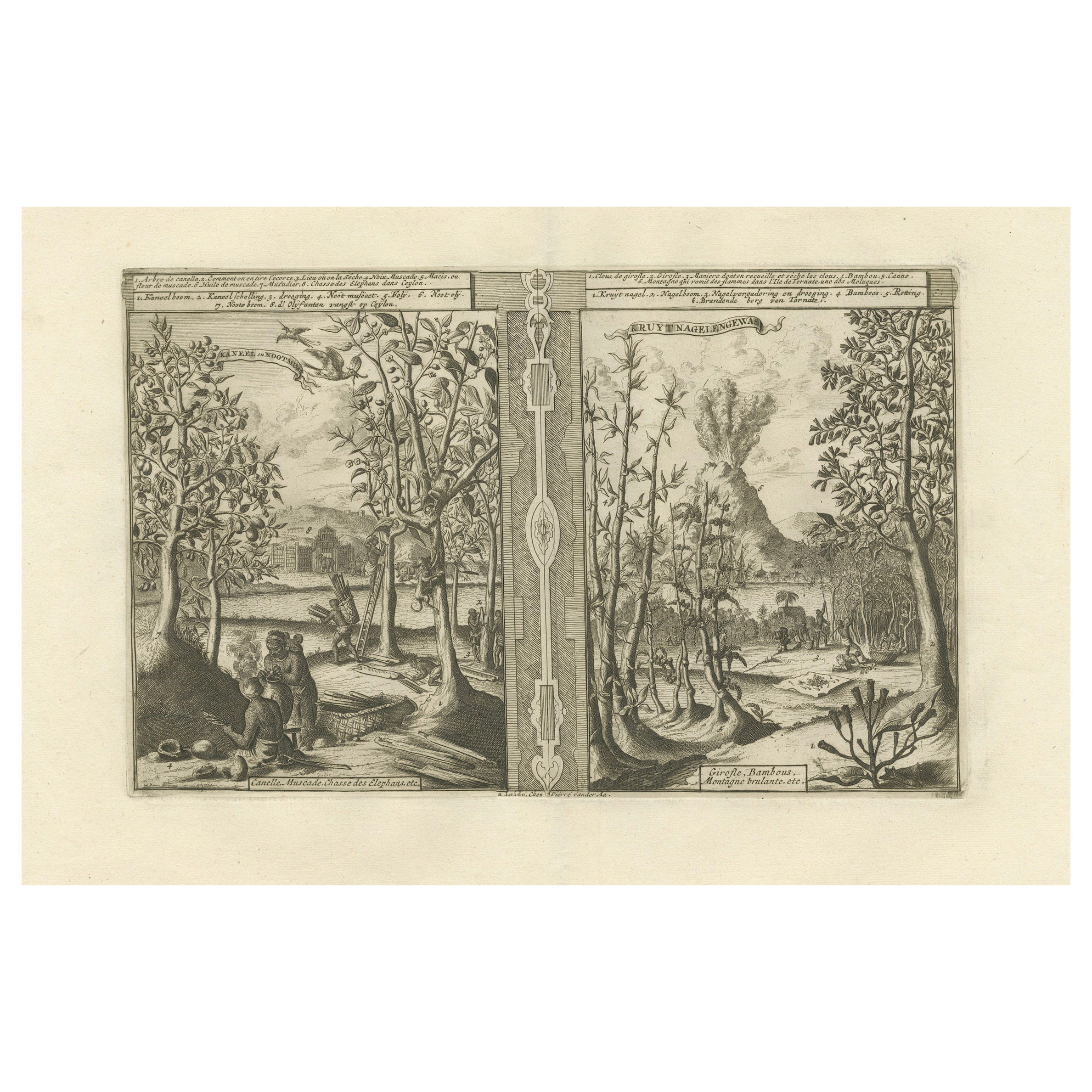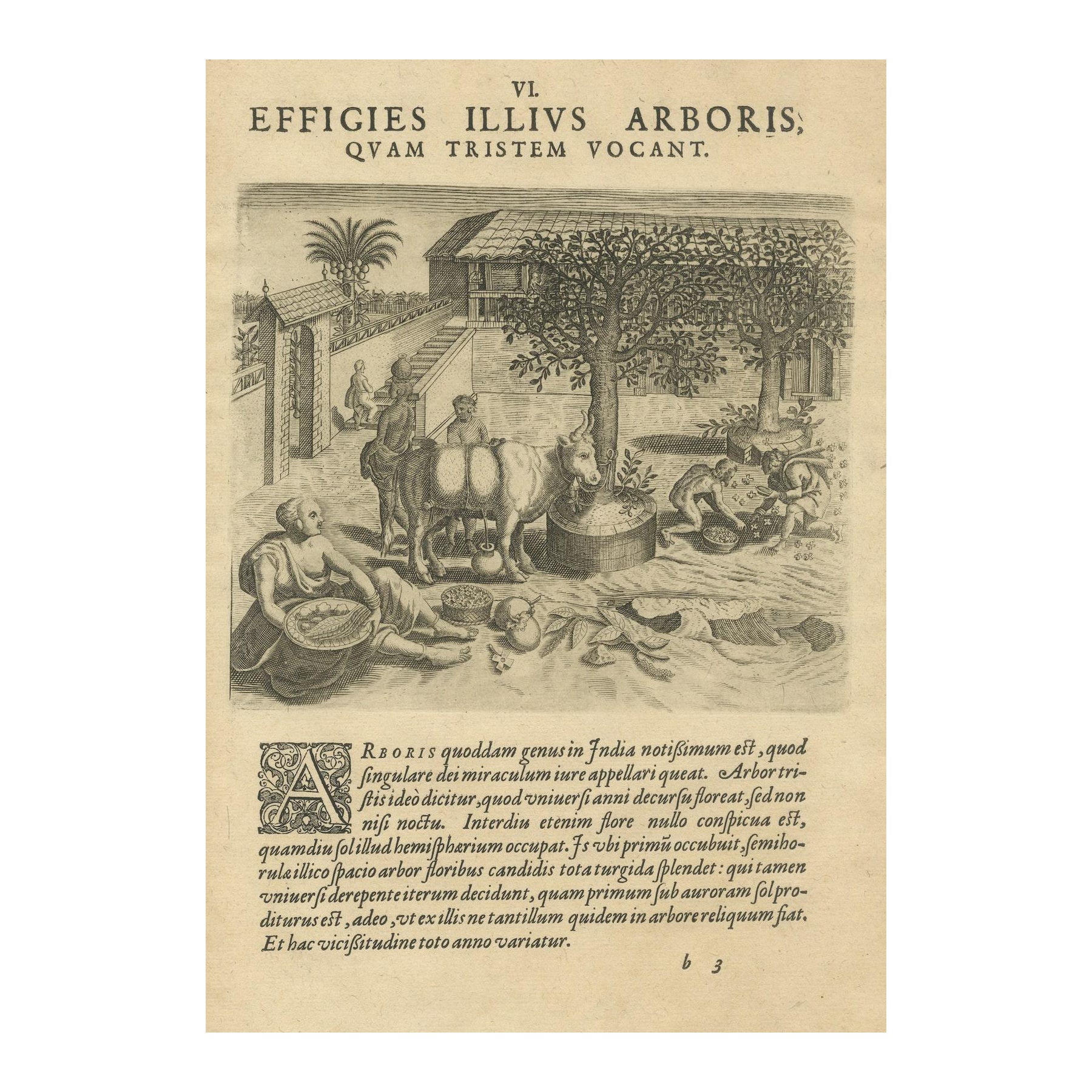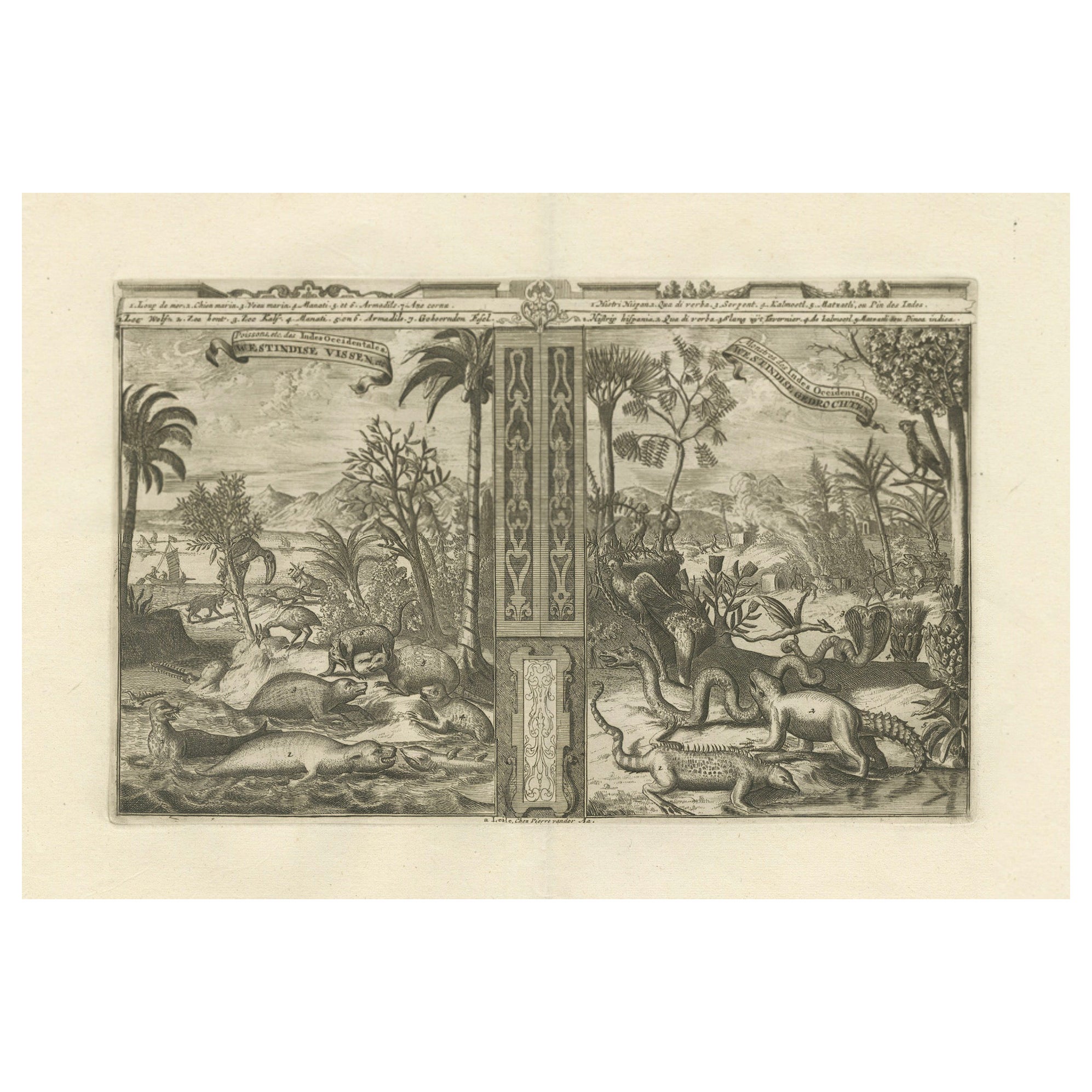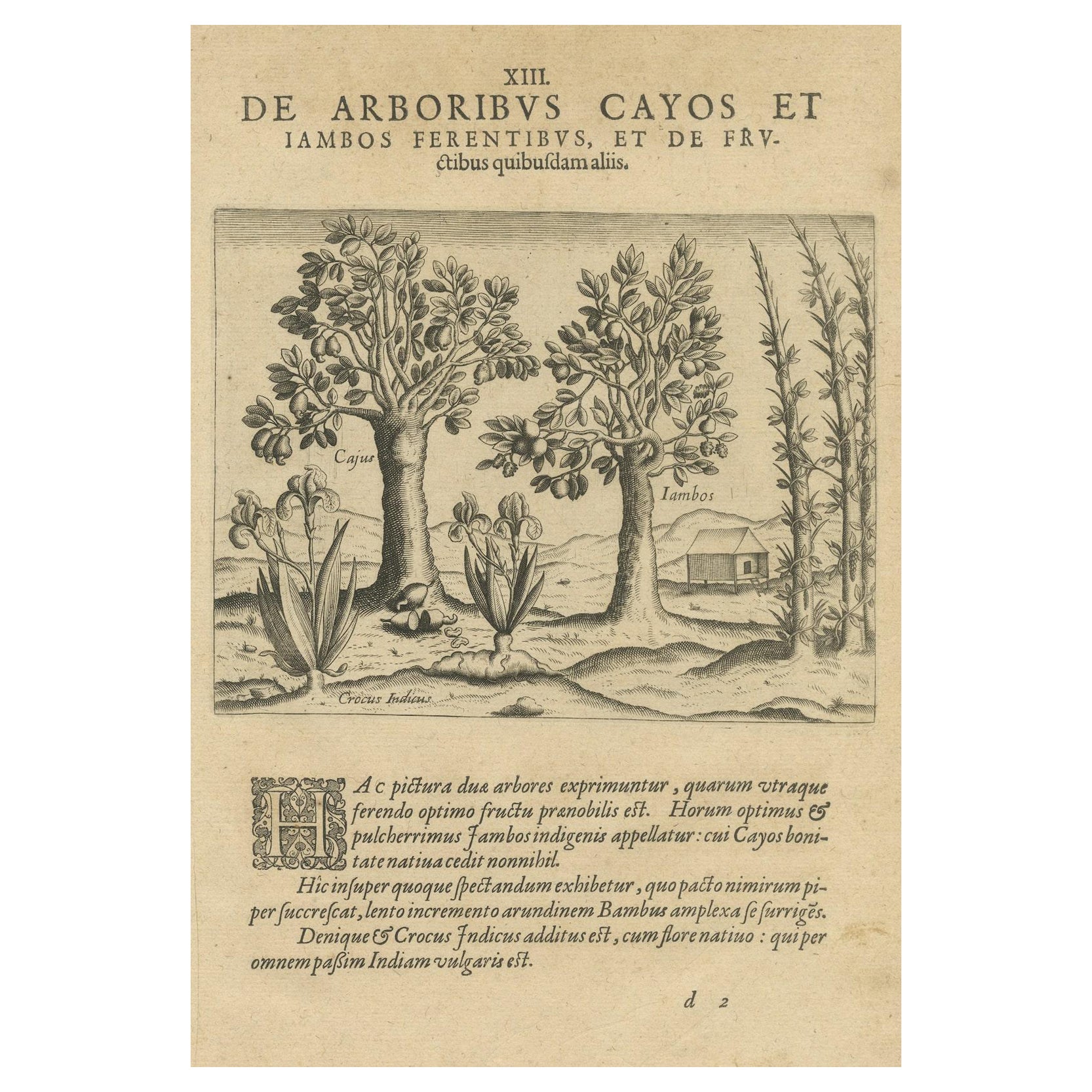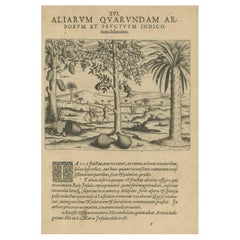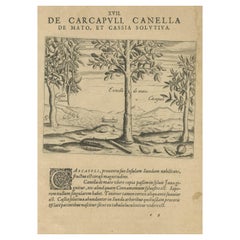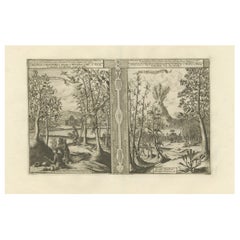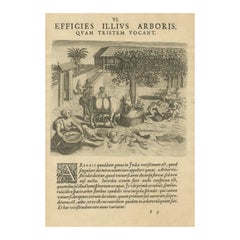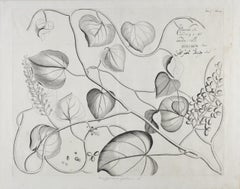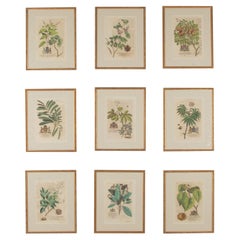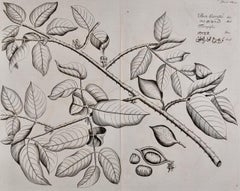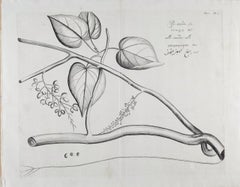Items Similar to Verdant Wonders: Exotic Trees and Spices of India in De Bry's 1601 Illustration
Want more images or videos?
Request additional images or videos from the seller
1 of 8
Verdant Wonders: Exotic Trees and Spices of India in De Bry's 1601 Illustration
$526.07
$657.5920% Off
£389.45
£486.8120% Off
€440
€55020% Off
CA$727.95
CA$909.9420% Off
A$802.55
A$1,003.1920% Off
CHF 419.87
CHF 524.8320% Off
MX$9,845.78
MX$12,307.2320% Off
NOK 5,285.30
NOK 6,606.6320% Off
SEK 4,942.59
SEK 6,178.2420% Off
DKK 3,351.65
DKK 4,189.5620% Off
About the Item
Title: "Verdant Wonders: Exotic Trees and Spices of India in De Bry's 1601 Illustration"
Description: This striking 1601 engraving by Theodore de Bry, titled "IDEA LANTOR, ASSA, PIMENTA DEL RABO, TALASSE, MANGOstans,&Picpris," showcases the rich botanical diversity of India, featuring an array of trees and plants highly valued for their culinary and medicinal properties. The Lantor, possibly a variant of a palm, stands tall with its slender trunk and large leaves. The Assa, likely a type of myrrh, and the Pimenta del Rabo, or tail pepper, hint at the spicy treasures that were eagerly sought by traders. The Talasse tree is shown with its broad, sturdy leaves, and the renowned Mangosteen is depicted with its lush, round fruits famed for their sweet, tangy flavor.
These plants, illustrated with such detail and care, were more than just food sources; they were symbols of the exotic abundance of the East Indies, representing wealth, mystery, and the allure of the unknown to the European audience of the time. De Bry’s engravings were a vital link in the chain of knowledge, bringing the wonders of distant lands into the libraries and salons of Europe, igniting imaginations and driving the fervor for exploration and trade.
Translation of the Latin text:
"Lantor or Cognos is the name for the mucilaginous class of Indian trees, whose leaves are of great length, used by Indians in place of paper. Pimenta del Rabo, also known as cubeb, grows on a certain tree: which the Indians hold in such high esteem that they do not hesitate to export them to foreign lands. Also added is the Tamarind tree, known as Assa, and the herb Talasse, celebrated in India: not to mention the fruit of the Mango tree, and the round black pepper produced in the soil, which the inhabitants of Sabang call ‘voctiant’."
The engraving is a page from Part IV of de Bry's "Petits Voyages," which narrates significant expeditions to the East Indies, including those led by Jan Juygen van Linschoten and Cornelis de Houtman between 1595-97, as well as the journey by Jacob van Neck and Wybrandt van Warwijck in 1598-99. These works were not merely artistic endeavors but also ethnographic records, showcasing indigenous peoples, fauna, flora, and the diverse riches of lands like India, Madagascar, and the East Indies.
Though Theodore de Bry began this ambitious project, it was continued posthumously by his family and later completed by his son-in-law, Matthaus Merian, in 1644. This particular engraving, rich in detail and drama, offers a window into the perilous and wondrous experiences of early explorers, and the ways in which these moments were captured and communicated to a European audience hungry for knowledge of the wider world.
- Dimensions:Height: 11.82 in (30 cm)Width: 7.88 in (20 cm)Depth: 0 in (0.02 mm)
- Materials and Techniques:Paper,Engraved
- Period:Early 17th Century
- Date of Manufacture:1601
- Condition:The condition of the print is very good, considering its age of over 400 years. Light brownish toning and foxing and some soiling due to handling, mainly around the edges. Please study this image carefully.
- Seller Location:Langweer, NL
- Reference Number:Seller: BG-13596-171stDibs: LU3054337756322
About the Seller
5.0
Recognized Seller
These prestigious sellers are industry leaders and represent the highest echelon for item quality and design.
Platinum Seller
Premium sellers with a 4.7+ rating and 24-hour response times
Established in 2009
1stDibs seller since 2017
2,609 sales on 1stDibs
Typical response time: <1 hour
- ShippingRetrieving quote...Shipping from: Langweer, Netherlands
- Return Policy
Authenticity Guarantee
In the unlikely event there’s an issue with an item’s authenticity, contact us within 1 year for a full refund. DetailsMoney-Back Guarantee
If your item is not as described, is damaged in transit, or does not arrive, contact us within 7 days for a full refund. Details24-Hour Cancellation
You have a 24-hour grace period in which to reconsider your purchase, with no questions asked.Vetted Professional Sellers
Our world-class sellers must adhere to strict standards for service and quality, maintaining the integrity of our listings.Price-Match Guarantee
If you find that a seller listed the same item for a lower price elsewhere, we’ll match it.Trusted Global Delivery
Our best-in-class carrier network provides specialized shipping options worldwide, including custom delivery.More From This Seller
View AllTropical Abundance: The Jackfruit and Palm Trees in De Bry's 1601 Engraving
Located in Langweer, NL
"Tropical Abundance: The Jackfruit and Palm Trees in De Bry's 1601 Engraving"
Description: This remarkable 1601 engraving by Theodore de Bry illustrates the lush vegetation of India...
Category
Antique Early 17th Century Prints
Materials
Paper
$526 Sale Price
20% Off
Spices of the Tropics: Cinnamon and Cassia in De Bry's 1601 Illustration
Located in Langweer, NL
Title: "Spices of the Tropics: Cinnamon and Cassia in De Bry's 1601 Illustration"
Description: This 1601 engraving by Theodore de Bry offers a detailed look at the spice-bearing tre...
Category
Antique Early 17th Century Prints
Materials
Paper
$459 Sale Price
20% Off
Exotic Bounty: The Spice Lands of the East Indies by R. de Hooghe, circa 1708
Located in Langweer, NL
Exotic Bounty: The Spice Lands of the East Indies
The engraving depicts scenes from the East Indies, not the West Indies, which was a common point of confusion in historical texts d...
Category
Antique Early 1700s Prints
Materials
Paper
$631 Sale Price
20% Off
The Melancholy Tree of the East: A 1601 de Bry Engraving from 'Indiae Orientalis
Located in Langweer, NL
This engraving from Theodore de Bry's "Indiae Orientalis" showcases a serene yet intriguing scene titled "EFFIGIES ILLIUS ARBORIS, QUAM TRISTEM VOCANT,...
Category
Antique Early 17th Century Prints
Materials
Paper
$526 Sale Price
20% Off
Tropical Paradise: The Diverse Fauna of the Indies by R. De Hooghe, circa 1708
Located in Langweer, NL
The engraving titled "Westindische Visserij" (West Indian Fisheries) is a fascinating artwork by Romeyn de Hooghe, printed by Pieter van der Aa, which vividly depicts the rich biodiv...
Category
Antique Early 1700s Prints
Materials
Paper
$631 Sale Price
20% Off
Exotic Flora of the Indies: The Cajus and Jambos Trees Copper Engraved in 1601
Located in Langweer, NL
Title: "Exotic Flora of the Indies: The Cajus and Jambos Trees in De Bry's 1601 Engraving"
Description: This detailed engraving by Theodore de Bry, dating back to 1601, beautifully illustrates two tropical trees, the Cajus and the Jambos, both renowned for their delectable fruits in the regions of India. The Cajus tree, likely referring to what is known today as the cashew, is depicted with its distinctive fruit that dangles below the swollen pedicel, commonly called the cashew apple. The Jambos tree, with its lush, dense foliage and abundant fruiting, could be related to the rose apple, known for its fragrant, rose-scented fruit.
Included in the scene is a depiction of the Indian Crocus, adding a touch of the diverse understory vegetation of the tropical climate. The image conveys a peaceful coexistence with nature, as indicated by a modest dwelling in the background, suggesting the integration of these trees into the daily lives of the local inhabitants for both nourishment and commerce.
The text is in Latin, and here is the English translation:
"In this picture, two trees are shown, each of which bears the most excellent and noble fruit. The best of these is called the Jambos, native to the region, which the inhabitants call Cayos. On this tree, nothing of note is bestowed.
Moreover, this also represents a marvelous spectacle, in which the slow-growing cane bamboo surrounds itself. Finally, the Indian Crocus has been added, which blooms with its native flower; which is widespread throughout all of India."
De Bry's engravings were pivotal in bringing the natural wealth of the New World and the East Indies to the European imagination. His work not only served as an artistic endeavor but also as an educational tool that fed the European appetite for knowledge about the vast diversity of the world's flora and fauna. This engraving, with its precision and attention to botanical detail, remains a significant historical record of the natural world as seen through the lens of the early modern European...
Category
Antique Early 17th Century Dutch Prints
Materials
Paper
You May Also Like
Citamerdu (Amrita) Plant: 17th Century Botanical Engraving by Hendrik van Rheede
Located in Alamo, CA
This is a rare 17th century engraving of a plant entitled "Citamerdu" by the Dutch botanist Hendrik van Rheede tot Drakenstein, plate 21 from his 'Hortus Indicus Malabaricus' (Garden of Malabar), published in Amsterdam in 1686 by Johann van Someren. The engraving depicts the Citamerdu plant, also known as Tinospora cordifolia plant or Amrita and Guduchi. It is a deciduous plant with heart-shaped leaves, greenish flowers, and pea-shaped fruits. Rheede's 19th century publication featured illustrations of exotic plants and fruits labelled with script in the upper right corner in Latin, Malay, Arabic, and Sanskrit. Hortus Indicus Malabaricus is believed to be the earliest comprehensive published work on the flora of Asia and the tropics. The 17th century treatise featured important illustrations of 740 plants of the region, including Indian medicinal plants.
The engraving is printed on 17th century laid, chain-linked paper, watermarked with an elaborate crown design. The sheet measures 15.75" high by 18.75" wide. There is a central fold, as issued. There are a few small spots, but the print is otherwise in excellent condition.
There are additional Rheede botanical engravings from his 'Hortus Indicus Malabaricus' publication that are listed on my 1stdibs storefront and online website. These would make for an impressive display grouping. A discount is available for purchase of two or more of the prints.
Hendrik Adriaan van...
Category
Late 17th Century Naturalistic Landscape Prints
Materials
Engraving
Collection of Nine 18th Century Tropical Botanical Engravings by Georg Dionysius
By Georg Dionysius Ehret
Located in Tetbury, Gloucestershire
Collection of nine 18th Century tropical botanical engravings by Georg Dionysius Ehret.
Hand coloured prints depicting local flora of Barbados. Each is dedicated to a prominent perso...
Category
Antique 18th Century German Prints
Materials
Paper
Fever Nut Plant "Ban Caretti": A 17th Century Engraving by Hendrik van Rheede
Located in Alamo, CA
This is a 17th century engraving of a fever or bonduc nut plant entitled "Ban Caretti" by Hendrik van Rheede tot Drakenstein, plate 20 from his 'Hortus Indi...
Category
Late 17th Century Naturalistic Landscape Prints
Materials
Engraving
Pee-amerdu Plant: A Rare 17th Century Botanical Engraving by H. van Rheede
Located in Alamo, CA
This is a rare 17th century engraving of a plant entitled "Pee-amerdu" by the Dutch botanist Hendrik van Rheede tot Drakenstein, plate 19 from his 'Hortus Indicus Malabaricus' (Garden of Malabar), published in Amsterdam in 1686 by Johann van Someren. The engraving depicts the Pee-amerdu plant, a large leafed plant climbing plant off the Malabar Coast in India. The plant is noted for its medicinal uses. It may be related to Tinospora species. Rheede's 19th century publication featured illustrations of exotic plants and fruits labelled with script in the upper right corner in Latin, Malay, Arabic, and Sanskrit. Hortus Indicus Malabaricus is believed to be the earliest comprehensive published work on the flora of Asia and the tropics. The 17th century treatise featured important illustrations of 740 plants of the region, including Indian medicinal plants.
The engraving is printed on 17th century laid, chain-linked watermarked paper. The sheet measures 14.88" high by 18.75" wide. There is a central fold, as issued. There are a few faint smudges, a spot in the upper margin and there is minimal irregularity of the left edge of the paper where the print was previously bound in the 17th century publication. The print is otherwise in very good condition.
There are additional Rheede botanical engravings from his 'Hortus Indicus Malabaricus' publication that are listed on my 1stdibs storefront and online website. These would make for an impressive display grouping. A discount is available for purchase of two or more of the prints.
Hendrik Adriaan van Rheede tot Drakenstein...
Category
Late 17th Century Naturalistic Landscape Prints
Materials
Engraving
Jan & Caspar Commelin: 17th Century Botanical Engravings, 1st Edition
By Jan & Caspar Commelin
Located in Richmond, GB
""Horti Medici Amstelodamensis Rariorum"" (Rarities of the Amsterdam Physic Garden),
1st edition, 1697 - 1701. ( Ref: Dunthorne: 81)
Jan Commelin (1629-1692) was Director of the Am...
Category
17th Century Paintings
Materials
Silver
Original Antique Print after Jan Luyken, Amsterdam, Genesis II, 1724
Located in St Annes, Lancashire
Wonderful copper-plate engraving after Jan Luyken
Published by Marten Schagen, Amsterdam. 1724
Text on verso
The measurement given is the paper size.
Category
Antique 1720s Dutch Renaissance Prints
Materials
Paper
More Ways To Browse
Antique Spices
Wiener Werkstatte Vase
Wood Carved Dog Head
Wood Slat Cabinet
Wood Snake Sculpture
Wooden Carved Trees
Wooden Rocking Horse
Wooden Wagon
Wrought Iron Balconies
Wrought Iron Balcony
Yellow Painted Chest
10 Drawer Dresser
17Th Century Casket
17th Century Italian Cassone
17th Century Chinese Incense Burner
18th Century Reproduction Furniture
18k Gold Snuff Box
18th Century Jasperware
